Top 30 Backyard Birds
Part I Part II Part III Part IV Part V Part VI
|
|
It had to happen at some point in this story of a limited "Top 30": an unthemed grab bag of five miscellaneous birds. We'd tell you what these birds have in common, but the answer is "not much." They will all come to feeders, and both the starling and the blackbirds are sometimes included among the ranks of "problem" birds (a problem we can solve, by the way). Other than that, they're unique! So go ahead and dive in, with the assurance that these are birds we've included because their individual merits supersede any arbitrary imposition of thematic grouping – each one is worth knowing.
16. White-breasted Nuthatch
|
White-breasted Nuthatch at suet feeder. Local picture by Laura Milholland. |
Identifying: Their distinctive foraging behavior makes all the nuthatches easy to recognize as they scurry up, down, and around tree trunks and limbs, investigating bark crannies for insects and wedging seeds or nuts in crevices for later consumption. They’re somewhat like little woodpeckers, but with more of a penchant for head-first descents and with thin beaks optimized for probing bark cracks. The White-breasted Nuthatch specifically has distinctive plumage, with white underparts and face, a dark cap, and a blue-gray back. Their call is a loud, repeated nasal yank, yank, yank.
Worth noting: Nuthatches are ready visitors to seed, suet, and nut feeders—if you are located in the appropriate habitat. White-breasted Nuthatches are oak specialists and you more or less must have some oaks in your vicinity to attract them, preferably mature deciduous species. We also have two other nuthatches in Marin, the Red-breasted and Pygmy Nuthatches, who are found in coniferous forest and will also come to feeders.
17. Dark-eyed Junco
|
Dark-eyed Junco's white outer tail feathers |
Identifying: Juncos are small, sparrow-sized birds that spend a lot of time scratching around on the ground. They are rendered fairly unique by being not only dark-eyed, but also dark-headed. When they take flight, you can also notice their contrasting white outer tail feathers. Absolute beginners might confuse them with Spotted Towhees, substantially larger birds with an overall much bolder color scheme and white dots on the wings.
Worth noting: We’ve got a good number of juncos all year round, with suitable nesting habitat found in many of our woodland and forest areas. But in winter numbers swell with additional migrant birds and locals go beyond their breeding grounds to search for food in flocks—often at backyard feeding stations. Juncos are very varied across the country, with several different races that can be confusingly illustrated in some field guides: our local race is known as the "Oregon Junco."
18. Bewick's Wren
Identifying: Like the White-breasted Nuthatch, the Bewick’s Wren is here as the most yard-likely representative of his tribe, with several other wrens present in Marin. In general, our various wrens can be recognized by their perkily cocked tails, long slender bills, generally brown color, and active, lively foraging. Bewick’s Wrens are easily recognized by their bold white eyebrow.
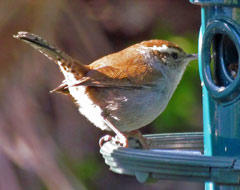 Local picture by Laura Milholland. |
Worth noting: Bewick is properly pronounced like Buick (Bew-ick), named after the master wood engraver Thomas Bewick. But many people—serious birders among them—persist in calling the bird a “Bee-wick’s Wren.” Don’t be too hard on them. Bewick’s Wrens are relatively adaptable to typical residential neighborhoods: in natural habitats they like a variety of scrubby settings including coastal scrub, dry chaparral, and brushier forest margins. They like to energetically investigate their way through moderately dense shrubs and brush, with the occasional momentary pause to sample seed, nut, suet, or Bark Butter feeders.
19. Blackbirds
|
Red-winged Blackbird |
Identifying: Male Red-winged Blackbirds are instantly recognizable: they are black, with bright red patches on their shoulders. Females are streaky and brown, with a lighter eyebrow. They can occur in single-sex flocks in an attempt to confuse you. Our second blackbird species is the Brewer’s Blackbird: they don’t have red shoulder patches, and males are black with iridescent purplish heads, while females are an unstreaky brown.
Worth noting: We admit that most people will not have red-winged blackbirds in their yard. But we know you all see them at a local feeding station, because they regularly visit our store feeders! The secret is our close proximity to water: the ponds behind the shopping center are overflowing with these guys. Our other very common blackbird, the Brewer’s Blackbird, is a parking lot specialist (among many open habitats), frequently seen strutting around looking for seeds and crumbs. You can observe and compare the two the next time you visit us.
20. Starling
|
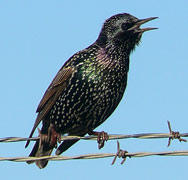
Picture by Linda Tanner |
Identifying: In their breeding plumage, starlings are iridescent black with yellow bills. In fall, they become liberally spangled with striking white spots more or less all over and their beaks may be dark, depending on your timing. They are of a similar size to blackbirds, also tend to flocks, and are also sometimes problematic at feeders.
Worth noting: Starlings were introduced from Europe to New York City in 1890 as part of a project to introduce all the birds mentioned in Shakespeare to America. (I'll have a starling shall be taught to speak nothing but ‘Mortimer’ says the irate Hotspur, dreaming of employing their talents at mimicry to annoy the stern Henry IV.) The small colony soon exploded to many millions, reaching the Bay Area in the 40s and becoming abundant in the 60s. Often they moved in at the expense of native cavity nesters whom they outcompeted, as well as annoying most everyone else with their impact on various crops, their taste for livestock feed, and their large and noisy colonies. On the plus side, their massive "murmurations" are quite a sight:
|


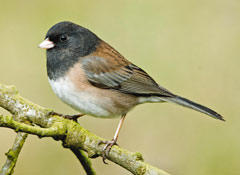
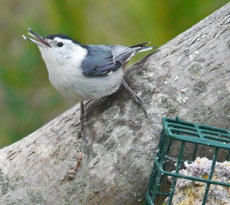
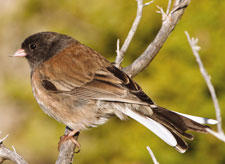
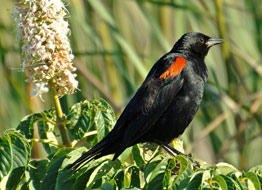
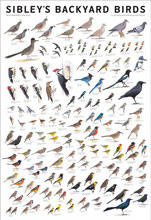 Featured Product: Sibley Backyard Poster
Featured Product: Sibley Backyard Poster